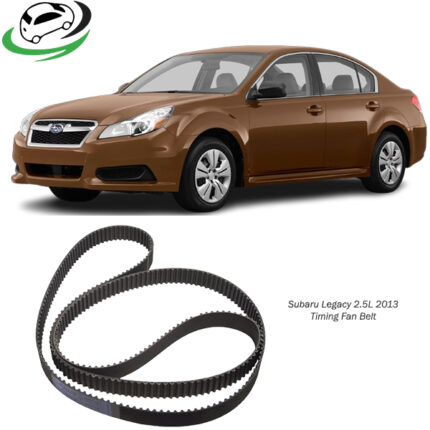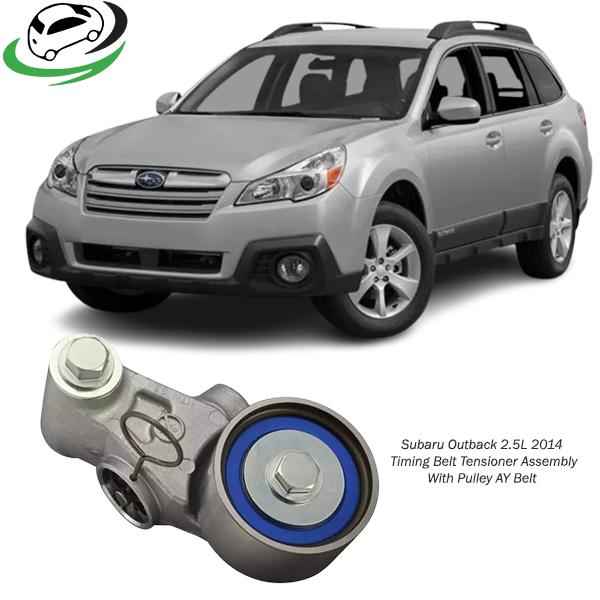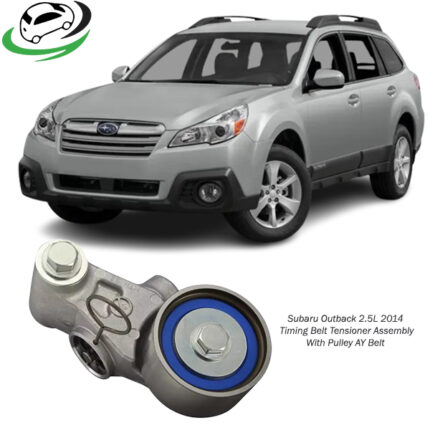-10%
Get Subaru Outback 2.5L 2014 Timing Belt Tensioner Assembly With Pulley Belt 13033AA042 in Kenya
A timing belt tensioner assembly with pulley AY belt is a critical component in an internal combustion engine, ensuring smooth and precise timing between the crankshaft and camshaft(s). This assembly, typically found in vehicles with a timing belt system, plays a vital role in regulating the engine’s timing mechanism, maintaining correct tension on the belt, and enabling the proper synchronization of various engine parts. In this detailed explanation, we will explore its function, benefits, maintenance tips, and how it contributes to the overall health of the engine.
1. Functions of the Timing Belt Tensioner Assembly with Pulley AY Belt
The timing belt tensioner assembly with pulley AY belt serves several key purposes within the engine:
a. Tension Management:
The tensioner keeps the timing belt taut and under the correct amount of tension. Timing belts naturally expand and contract due to heat, mechanical stresses, and age. If the belt becomes too loose, it could slip or even jump teeth on the camshaft or crankshaft gears, leading to timing misalignment. This can cause engine misfires, reduced power output, or catastrophic damage if valves come into contact with pistons. A properly functioning tensioner prevents these issues by ensuring the belt stays in optimal tension during all engine conditions.
b. Alignment Support:
The tensioner and its accompanying pulley help guide and keep the belt aligned. This prevents lateral movement or misalignment of the belt, which could cause it to fray or wear unevenly. Over time, a misaligned belt can lead to premature failure, which may cause costly damage to the engine.
c. Damping Vibrations:
The tensioner assembly also serves to absorb vibrations caused by the engine’s operational forces, which helps reduce the chances of belt wear or failure. These vibrations can be harmful if not managed, as they can contribute to belt oscillation or additional stress on the camshaft or crankshaft sprockets.
d. Timing Accuracy:
Because the timing belt connects the crankshaft and camshaft(s), it is directly responsible for ensuring accurate timing of the intake and exhaust valve events. Any slack in the belt would disrupt this precise timing, leading to poor engine performance, reduced fuel efficiency, or engine damage. The tensioner assembly keeps the belt in the correct position to prevent any slippage that could alter the timing.
2. Benefits of the Timing Belt Tensioner Assembly with Pulley AY Belt
The timing belt tensioner assembly provides several key benefits that contribute to engine longevity and performance:
a. Enhanced Engine Performance:
By maintaining the correct timing between the crankshaft and camshaft(s), the timing belt tensioner ensures that the engine operates smoothly. The precise control of valve and piston movement allows for optimal combustion, leading to better fuel efficiency and performance.
b. Increased Durability and Belt Longevity:
A well-maintained tensioner assembly reduces the stress on the timing belt, thereby extending its lifespan. The tensioner ensures even wear across the belt, preventing premature failure and protecting the engine from potential damage.
c. Prevention of Costly Engine Damage:
Without a properly functioning tensioner, the risk of the timing belt slipping or breaking increases, which could lead to engine damage. In interference engines, a broken timing belt could cause valves to collide with pistons, resulting in costly repairs. The tensioner protects against these scenarios by keeping the belt secure.
d. Smooth Operation and Noise Reduction:
An optimally functioning tensioner assembly reduces vibration and oscillation of the timing belt, leading to quieter engine operation. It also minimizes wear on the belt, reducing the chances of belt squealing or other noise issues.
3. Components of the Timing Belt Tensioner Assembly
A timing belt tensioner assembly typically consists of the following components:
a. Tensioner Pulley:
The pulley is the rotating component in contact with the timing belt, helping guide it along its path. It is often made from a high-strength material like steel or aluminum to withstand the stress from continuous belt contact.
b. Spring Mechanism:
The tensioner contains a spring-loaded mechanism that automatically adjusts the tension on the timing belt as it expands or contracts due to temperature fluctuations or wear.
c. Hydraulic or Mechanical Tensioner:
Tensioners can be hydraulic or mechanical. Hydraulic tensioners use fluid pressure to apply tension to the belt, providing smooth, automatic adjustments. Mechanical tensioners rely on a spring mechanism, which may require manual adjustment.
d. Mounting Bracket:
This component holds the tensioner in place within the engine compartment, ensuring it remains securely fixed to the engine block.
4. Maintenance Tips for Timing Belt Tensioner Assembly with Pulley AY Belt
Proper maintenance of the timing belt tensioner assembly is crucial to prevent premature wear and avoid costly repairs:
a. Regular Inspections:
It’s essential to inspect the tensioner and timing belt during routine maintenance. Look for signs of wear, cracking, or glazing on the belt, and check the tensioner pulley for smooth rotation and absence of play or noise. Replace any worn components immediately.
b. Belt Replacement Intervals:
The timing belt should be replaced according to the vehicle manufacturer’s recommended intervals, typically every 60,000 to 100,000 miles. Along with the belt, it’s advisable to replace the tensioner assembly at the same time, as they tend to wear out together.
c. Listen for Unusual Noises:
A failing tensioner can produce unusual sounds, such as rattling or squealing. These noises indicate that the tensioner pulley may be misaligned or the tensioner mechanism is failing. Address these issues promptly to avoid further damage.
d. Monitor Belt Tension:
If your vehicle uses a mechanical tensioner, it may need periodic manual adjustment to ensure proper belt tension. Hydraulic tensioners, on the other hand, adjust automatically, but they still require inspection to ensure they are functioning properly.
e. Replace the Tensioner with the Belt:
Whenever you replace the timing belt, it’s generally recommended to replace the tensioner assembly as well. Over time, the tensioner’s components wear out, and failing to replace it could lead to premature failure of the new belt.
5. Common Signs of a Failing Timing Belt Tensioner Assembly
A failing timing belt tensioner assembly can cause various problems, including:
a. Belt Slippage:
If the tensioner is not maintaining proper tension, the belt may slip, causing engine misfires, rough idling, or power loss.
b. Excessive Belt Wear:
A worn or damaged tensioner pulley can cause uneven wear on the timing belt, leading to fraying or breaking.
c. Engine Noises:
Rattling or squealing noises from the engine bay can indicate a failing tensioner or misaligned pulley.
d. Poor Engine Performance:
If the timing belt slips due to a faulty tensioner, the engine’s timing can be thrown off, resulting in reduced performance, poor fuel economy, or engine damage.
Conclusion
The timing belt tensioner assembly with pulley AY belt is essential for maintaining the correct timing and smooth operation of an engine. By ensuring proper belt tension and alignment, it protects against engine misfires, power loss, and potential engine damage. Regular maintenance, timely inspections, and following the manufacturer’s recommended replacement intervals are crucial for prolonging the lifespan of both the timing belt and the tensioner assembly. Proper care will ensure optimal engine performance and prevent costly repairs, safeguarding your vehicle’s longevity.
Follow us on Facebook for more parts.





Reviews
Clear filtersThere are no reviews yet.